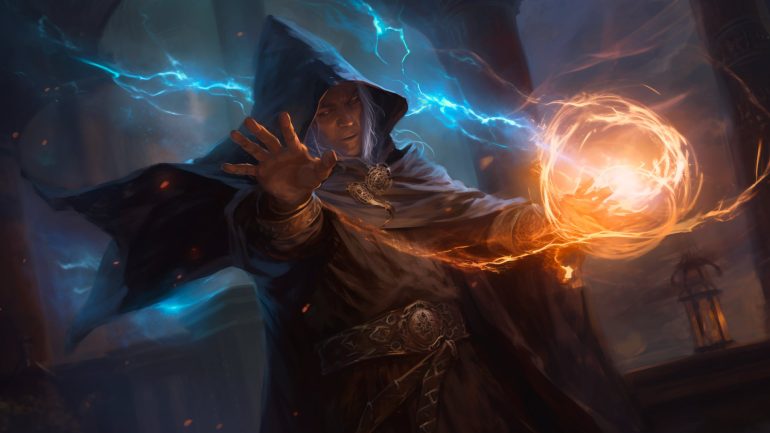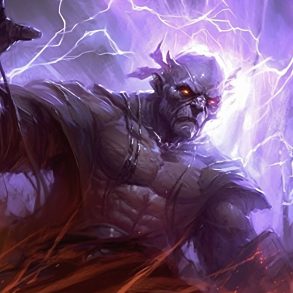What is Counterspell 5E?
Counterspell 5E (PHB, p. 228) in DnD 5E is a 3rd level abjuration spell, which is available natively to Sorcerers, Warlocks, and Wizards. It requires only a somatic component and is cast as a reaction, which can be taken when you see a creature casting a spell within 60 feet of you. If the spell is 3rd level or lower it automatically fails and the spell slot is wasted, if it is a higher level the spellcaster must succeed on a spellcasting check to counter it. The DC for this check is 10 + the target spell’s level, for example countering Polymorph, a 4th level spell, would be a DC of 14. This check uses the caster’s spellcasting modifier and doesn’t add proficiency unless the caster has a feature that does so.
If cast with a spell slot of 4th level or higher, the level of spell automatically countered increases to match the level of spell slot used. For example, if you cast Counterspell with a 6th level spell slot, it can automatically counter spells of 6th level or lower, whilst still needing a check to counter spells of 7th level or higher.
Is Counterspell 5E a good spell?
Counterspell has the potential to be a game-changing spell that can trivialize otherwise deadly encounters, however, it’s hard to outright say that the spell is good or recommended when it is so niche. To make learning it worthwhile, the campaign you’re playing in needs to feature enemy spellcasters regularly. Even then, with a number of strategies to avoid it and its inability to counter spells cast from items or spell-like abilities, it can end up being useless against some enemies. Because of this, it’s recommended that maybe one party member has access to this spell if you expect to fight spellcasters regularly, but it shouldn’t be relied upon.
To get the most out of this spell, consider being a Bard or Abjurer Wizard, whose Jack of All Trades and Improved Abjuration respectively increase the chance of succeeding on Counterspelling a higher level spell.
How can you get Counterspell 5E?
If you like the sound of denying enemy spellcasters their ace in the hole, fear not! Here is a list of how you can grab this spell:
- Sorcerer, Warlock, and Wizard – All of these classes get Counterspell on their spell list.
- Arcane Trickster (Rogue Subclass) – This Rogue can choose spells from the Wizard spell list, and can choose Counterspell as one of their spells from 14th level as it doesn’t match their restrictions.
- Eldritch Knight (Fighter Subclass) – Similar to above, this Fighter subclass can choose spells from the Wizard list and can choose Counterspell as it matches their abjuration restriction.
- Oath of Redemption (Paladin Subclass) – These mostly-peaceful paladins get access to Counterspell as an always-prepared spell from 9th level thanks to their Oath Spells feature.
- Oath of Watchers (Paladin Subclass) – Similar to above, these vigilant Paladins get Counterspell as an Oath Spell.
- Magical Secrets (Bard Class Feature) – This feature allows a Bard to steal a spell from any spell list, whilst this could be a bit of a waste used on Counterspell for most Bards due to the high-level nature of the feature. However, Lore Bards might be interested as they get Magical Secrets at a much earlier level than other Bards.
How to roleplay the Counterspell 5E
Need some help roleplaying the Counterspell? Here are some examples to help you out:
- As the party faces off against the malevolent witch, her hands begin to crackle with dark energy, the beginnings of a devastating spell taking form. Quick to react, the Wizard points her staff towards the witch, invoking Counterspell. The magic from her staff rushes forward, colliding with the witch’s spell and causing it to fizzle out into harmless sparks before it can even take effect.
- Engaged in a magical duel against an enemy Sorcerer, the Warlock watches his adversary’s movements carefully. He sees the mage casting gestures for a Fireball spell and reacts swiftly, calling upon his own power. The sorcerer’s fiery attack dissipates before it can leave his hand, thwarted by Harken’s fast reflexes and keen understanding of arcane magic.
- During a tense standoff with a rival group of adventurers, the studious Bard sees the enemy Cleric starting to cast a spell. Recognizing the rhythm and flow of the incantation, she quickly strums her lute, her music warping the weave of magic around her to cast her rebuttal. The divine magic dissipates into a gentle breeze, the Cleric’s spell negated before it can harm her party.
Hopefully, this article was informative and helped deal with and pesky Red Wizards you might come up against. If you’re interested in this spell for your next Warlock build, then check out our Warlock 5E guide, or If you’re interested in researching other spells then check out our DnD 5e spells section, Good luck out there adventurers, until next time, remember to shout “nope!” when you cast this!






